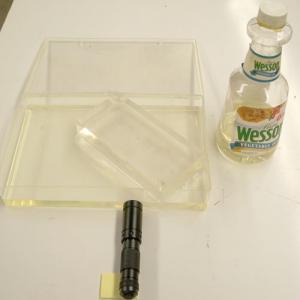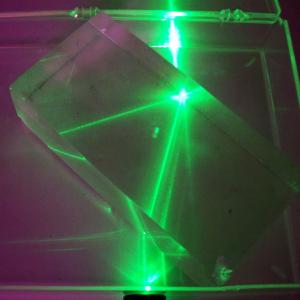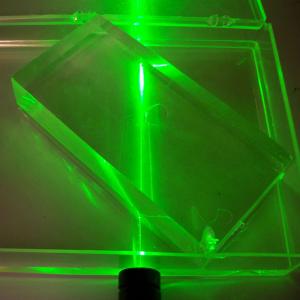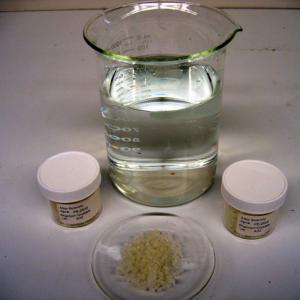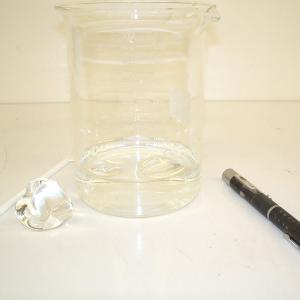College of Liberal Arts & Sciences
6A40.33 - Index of Refraction - Glass or Plastic Block, Expanding Crystals
Place the large glass or plastic block into the clear plastic box as shown. Direct a laser beam through the box and into the block at a 45 degree angle to the edge of the block. Note that the entrance and exit beams are offset from one another. Pour Wesson oil into the box to just above the level of the laser beam and observe that now the laser beam is now a straight line with no offset because the Wesson oil and the plastic block have the same index of refraction.
NOTE: The following takes 1 full days notice.
The "Phantom Crystals" or "Growing Spheres" are commonly used as a substitute for soil in potted plants or as an absorbent in baby diapers. They are able to absorb a large amount of water and keep it from evaporating, and so they are used to keep plants from drying out under stress conditions. The crystals are a mixture of: 25% Hydroxyethel Methacrylate, methacrylic acid, acrylimide copolymer, cross-linked homopolymer for absorption and desorption of water, and 35% silica to stabilize the system. They have the same index of refraction as water and are therefore invisible in what looks like a beaker of pure water. Shine a laser beam through the beaker and the beam goes straight through as you would expect if the beaker contained only water. Pour some of the water out so the crystals are exposed and you will see the laser beam being refracted by the individual expanded crystals.
- Carlos Daniel Frazao, Wellington dos Santos Souza, "A Proposed Experimental Activitiy to Determine Optical Properties of Acrylic by Using Smartphones and Measurement Instruments", TPT, Vol. 62, #7, Oct. 2024, p. 610.
- Cristiano M. B. Cordeiro, Eric Fujiwara, "A Quantitative Experiment of Liquid Dispersion Using Merely a Partially Submerged Mirror and Sunlight", TPT, Vol. 60, #2, Feb. 2022, p. 140.
- Marshall Ellenstein, "Old Wine in New Bottles", TPT, Vol. 55, #7, Oct. 2017, p. 439.
- Marina Milner-Bolotin, "Water Pearls Optics Challenges for Everbody", TPT, Vol. 50. #3, Mar. 2012, p. 144.
- Gordon R. Gore, "Physics Fun with Jelly Marbles", TPT, Vol. 47, #9, Dec. 2009, p. 606.
- Robert Gardner, "Mirrors in Air and Water", TPT, Vol. 14, #2, Feb. 1976, p. 114, also A Potpourri of Physics Teaching Ideas - Optics and Waves, p. 199.
- Borislaw Bilash II, “Ghost Crystals“, A Demo A Day – A Year of Physical Science Demonstrations, p. 312.
- Julius Sumner Miller, Q206 & A206, Millergrams II – Some More Enchanting Questions for Enquiring Minds, p. 60 & 110.
Disclaimer: These demonstrations are provided only for illustrative use by persons affiliated with The University of Iowa and only under the direction of a trained instructor or physicist. The University of Iowa is not responsible for demonstrations performed by those using their own equipment or who choose to use this reference material for their own purpose. The demonstrations included here are within the public domain and can be found in materials contained in libraries, bookstores, and through electronic sources. Performing all or any portion of any of these demonstrations, with or without revisions not depicted here entails inherent risks. These risks include, without limitation, bodily injury (and possibly death), including risks to health that may be temporary or permanent and that may exacerbate a pre-existing medical condition; and property loss or damage. Anyone performing any part of these demonstrations, even with revisions, knowingly and voluntarily assumes all risks associated with them.
